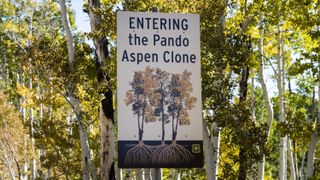QUICK FACTS
Name: Pando
Location: Fishlake National Forest, Utah
Coordinates: 38.52444764419252, -111.75068313176233
Why it’s incredible: Pando looks like a forest, but it’s actually one giant tree.
Pando is an ancient quaking aspen tree (Populus tremuloides) with 47,000 genetically identical stems, or tree trunks, connected to a vast underground root system. Each stem is a clone of the one next to it and originates from a single seed that started growing up to 80,000 years ago during the last ice age.
Pando — Latin for “I spread” — is the largest known tree on Earth and the heaviest living organism on record. The colony extends over 106 acres (43 hectares) and weighs an estimated 6,500 tons (5,900 metric tons), which is equivalent to 40 blue whales or three times the world’s largest single-stem tree — California’s General Sherman giant sequoia (Sequoiadendron giganteum).
Related: Listen to the sounds of Pando, the largest living tree in the world
Researchers realized that Pando is a single organism in the 1970s, and geneticists have since confirmed that what looks to the untrained eye like a forest is actually one giant clone, according to the U.S. Forest Service. A recent DNA analysis of hundreds of tree samples suggested Pando is between 16,000 and 80,000 years old, making it one of the oldest living organisms in the world — although that research, which was published Oct. 24, 2024 to the preprint database bioRxiv, has not yet been peer reviewed.
Some of Pando’s stems are more than 130 years old, according to the Forest Service, and the plant should continuously regenerate the parts of itself that wither and die. But that hasn’t been the case in recent years.
Pando reproduces asexually, creating clones of itself rather than mixing its DNA with that of other trees. The root system produces genetically identical shoots that grow upward, filling in the gaps between stems and keeping the plant alive for thousands of years. But according to a 2018 study, aerial images taken of Pando over a period of 72 years show stark signs of decline, including larger gaps in the canopy and aging stems that aren’t being replaced by younger ones.
“Imagine walking into a town of 50,000 people where everybody in town was 85 years old,” Paul Rogers, an adjunct associate professor of ecology at Utah State University and director of the Western Aspen Alliance, told National Geographic in…
Click Here to Read the Full Original Article at Livescience…

